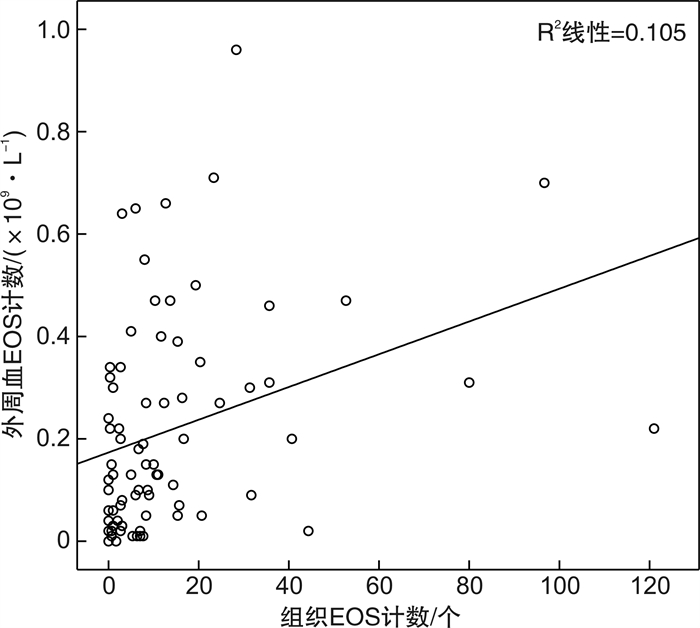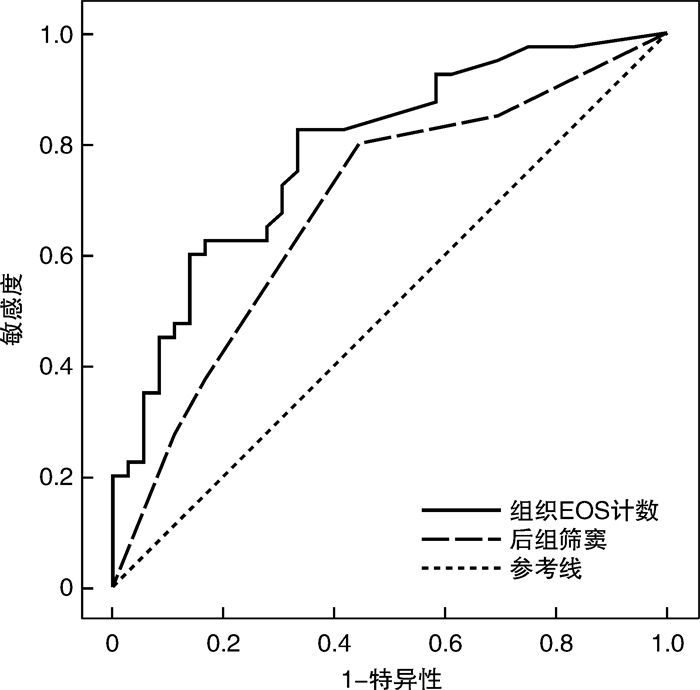Predictive factors of asymptomatic airway hyperresponsiveness in chronic rhinosinusitis with nasal polyps
-
摘要: 目的 探讨慢性鼻窦炎伴鼻息肉(CRSwNP)患者出现无症状气道高反应(AAHR)的预测因素及价值, 为临床评估气道高反应提供理论依据。方法 回顾性分析2016年5月-2020年10月在山西医科大学附属汾阳医院耳鼻咽喉科住院治疗并已行支气管激发试验检查的CRSwNP患者76例, 其中AAHR 40例, 无气道高反应(NAHR)36例。对患者的临床症状、鼻窦CT评分、外周血及鼻息肉组织嗜酸粒细胞(EOS)计数进行对比分析。应用Logistic回归分析AAHR的危险因素, 应用受试者工作特征曲线判断参数的预测价值。结果 与NAHR组比较, AAHR组患者张口呼吸、鼻后滴漏症状更多, 鼻窦CT筛窦、蝶窦、嗅裂评分及总分更高, 外周血及鼻息肉组织EOS计数更高, 差异均有统计学意义(P < 0.05)。外周血与鼻息肉组织EOS计数呈正相关(r=0.324, P < 0.01)。鼻后滴漏、高后组筛窦评分及鼻息肉组织EOS计数是发生AAHR的危险因素。鼻息肉组织EOS计数较后组筛窦评分预测价值高(AUC分别为0.786和0.685)。当后组筛窦评分≥1.5时, 敏感度为80.0%, 特异性为55.6%;当鼻息肉组织EOS计数≥5.67/HPF时, 敏感度为82.5%, 特异性为66.7%。结论 CRSwNP患者出现AAHR与临床症状、鼻窦CT评分、外周及鼻息肉组织EOS计数有关, 后组筛窦评分及鼻息肉组织EOS计数可用于预测AAHR, 其中鼻息肉组织EOS预测价值更高。Abstract: Objective To explore the predictive factors for asymptomatic airway hyperresponsiveness(AAHR) in patients with chronic rhinosinusitis with nasal polyps(CRSwNP).Methods A total of 76 CRSwNP patients who were hospitalized in the Department of Otorhinolaryngology of Fenyang Hospital affiliated to Shanxi Medical University from May 2016 to October 2020 were retrospectively analyzed, including 40 patients in AAHR group and 36 patients in non-airway hyperresponsiveness(non-airway hyperresponsiveness, NAHR) group. The clinical symptoms, CT score of paranasal sinuses, eosinophil(EOS) count in peripheral blood and nasal polyp tissue were compared and analyzed. Logistic regression was used to analyze the risk factors of AAHR, and receiver operating characteristics curve was used to judge the predictive value of the parameters.Results Compared with NAHR group, AAHR group had more symptoms of mouth breathing and postnasal drip, higher total score of CT in ethmoid sinus, sphenoid sinus, olfactory cleft, and more EOS count in peripheral blood and nasal polyp tissue. The differences were statistically significant. There was a positive correlation between EOS count in peripheral blood and in nasal polyp tissue(r=0.324, P < 0.01). Postnasal drip, high posterior ethmoid sinus(PE) score and nasal polyp tissue EOS count were risk factors for AAHR. The predictive value of nasal polyp tissue EOS count was higher than that of PE score(AUC=0.786 and 0.685, respectively). When the PE score was ≥1.5, the sensitivity was 80.0% and the specificity was 55.6%. When the nasal polyp tissue EOS count was ≥5.67/HPF, the sensitivity was 82.5% and the specificity was 66.7%.Conclusion The occurrence of AAHR in patients with CRSwNP was related to clinical symptoms, paranasal sinus CT score, peripheral and nasal polyp tissue EOS count. PE score and nasal polyp tissue EOS count can be used to predict AAHR, however nasal polyp tissue EOS has higher predictive value.
-
Key words:
- sinusitis /
- nasal polyps /
- airway hyperresponsiveness /
- asthma /
- eosinophil
-

-
表 1 AAHR组和NAHR组基本资料、临床症状及外周血检测比较
项目 AAHR组(n=40) NAHR组(n=36) χ2(Z) P 男/女 27/13 17/19 3.196 0.074 年龄/岁,M[P25,P75] 51[35, 57] 50[40, 57] (-0.177) 0.860 吸烟/例(%) 17(42.5) 11(30.6) 1.162 0.281 吸烟指数/(M[P25,P75]) 0[0, 500] 0[0, 505] (-1.017) 0.309 饮酒/例(%) 17(42.5) 9(25.0) 2.578 0.108 变应性鼻炎/例(%) 9(22.5) 6(16.7) 0.407 0.523 病程/月,M[P25,P75] 30[12, 60] 24[7, 57] (-0.676) 0.499 鼻塞/例(%) 40(100.0) 35(97.2) — 0.474a) 嗅觉减退/例(%) 27(67.5) 20(55.6) 1.146 0.284 头部胀痛/例(%) 8(20.0) 12(33.3) 1.737 0.188 流涕/例(%) 36(90.0) 35(97.2) 0.648 0.205 张口呼吸/例(%) 16(40.0) 6(16.7) 5.015 0.025 鼻后滴漏/例(%) 14(35.0) 5(13.9) 4.504 0.034 打喷嚏/例(%) 13(32.5) 8(22.2) 1.001 0.317 血EOS计数/(×109/L) 0.23[0.08,0.45] 0.10[0.03,0.22] (-2.389) 0.018 注:a)Fisher确切概率法。 表 2 改良Lund-Mackay鼻窦CT评分对比
各组鼻窦及总分 改良Lund-Mackay评分 Z P AAHR组(n=40) NAHR组(n=36) 上颌窦 2.00[2.00,3.00] 2.00[2.00,3.00] -0.222 0.824 前组筛窦 4.00[2.25,4.00] 2.00[1.00,3.00] -3.396 0.001 后组筛窦 2.00[2.00,4.00] 1.00[0.00,2.00] -2.876 0.004 蝶窦 2.00[0.00,2.00] 0.00[0.00,1.75] -2.440 0.015 额窦 2.00[1.00,4.00] 2.00[0.25,3.00] -1.139 0.255 窦口鼻道复合体 4.00[4.00,4.00] 4.00[2.00,4.00] -1.580 0.114 嗅裂 2.00[1.00,4.00] 1.00[0.00,2.00] -2.323 0.020 总分 18.50[12.00,23.00] 13.50[8.00,19.75] -2.573 0.010 表 3 多因素二元Logistic回归分析
预测因子 P值 OR 95%CI 鼻后滴漏 0.029 4.390 1.164~16.555 血EOS计数 0.424 0.999 0.995~1.002 鼻息肉组织EOS计数 0.005 1.103 1.030~1.182 前组筛窦 0.642 1.234 0.510~2.988 后组筛窦 0.049 1.498 1.001~2.243 蝶窦 0.535 1.222 0.649~2.300 嗅裂 0.403 0.674 0.267~1.698 总分 0.873 1.188 0.145~9.725 -
[1] 王梦瑶, 王斌全, 王磊, 等. 慢性鼻窦炎患者生存质量研究进展[J]. 临床耳鼻咽喉头颈外科杂志, 2021, 35(1): 84-87. https://www.cnki.com.cn/Article/CJFDTOTAL-LCEH202101024.htm
[2] Phillips KM, Talat R, Caradonna DS, et al. Quality of life impairment due to chronic rhinosinusitis in asthmatics is mediated by asthma control[J]. Rhinology, 2019, 57(6): 430-435.
[3] 中华耳鼻咽喉头颈外科杂志编辑委员会鼻科组, 中华医学会耳鼻咽喉头颈外科学分会鼻科学组. 中国慢性鼻窦炎诊断和治疗指南(2018)[J]. 中华耳鼻咽喉头颈外科杂志, 2019, 54(2): 81-100. doi: 10.3760/cma.j.issn.1673-0860.2019.02.001
[4] Westerhof GA, Coumou H, de Nijs SB, et al. Clinical predictors of remission and persistence of adult-onset asthma[J]. J Allergy Clin Immunol, 2018, 141(1): 104-109. e3. doi: 10.1016/j.jaci.2017.03.034
[5] Grayson JW, Li W, Ho J, et al. Topography of polyp recurrence in eosinophilic chronic rhinosinusitis[J]. Int Forum Allergy Rhinol, 2020, 10(5): 604-609. doi: 10.1002/alr.22529
[6] 中华医学会呼吸病学分会哮喘学组. 支气管哮喘防治指南(2016年版)[J]. 中华结核和呼吸杂志, 2016, 39(9): 675-697. doi: 10.3760/cma.j.issn.1001-0939.2016.09.007
[7] Chen F, Hong H, Sun Y, et al. Nasal interleukin 25 as a novel biomarker for patients with chronic rhinosinusitis with nasal polyps and airway hypersensitiveness: A pilot study[J]. Ann Allergy Asthma Immunol, 2017, 119(4): 310-316. e2. doi: 10.1016/j.anai.2017.07.012
[8] Bonfils P, Avan P. Non-specific bronchial hyperresponsiveness is a risk factor for steroid insensitivity in nasal polyposis[J]. Acta Otolaryngol, 2004, 124(3): 290-296. doi: 10.1080/00016480310016938
[9] Chen F, Luo X, Xu R, et al. Evaluation of airway hyperresponsiveness in chronic rhinosinusitis: values of sinus computed tomography[J]. Ann Allergy Asthma Immunol, 2014, 113(6): 609-613. doi: 10.1016/j.anai.2014.09.006
[10] Han DH, Kim SW, Cho SH, et al. Predictors of bronchial hyperresponsiveness in chronic rhinosinusitis with nasal polyp[J]. Allergy, 2009, 64(1): 118-122. doi: 10.1111/j.1398-9995.2008.01841.x
[11] 杨宏宽, 张佳颖, 王芳, 等. Astograph法支气管激发试验在诊断哮喘的作用研究[J]. 实用医学杂志, 2017, 33(22): 3807-3809. doi: 10.3969/j.issn.1006-5725.2017.22.033
[12] Fokkens WJ, Lund VJ, Hopkins C, et al. European Position Paper on Rhinosinusitis and Nasal Polyps 2020[J]. Rhinology, 2020, 58(Suppl S29): 1-464.
[13] 孙虹, 张罗. 耳鼻咽喉头颈外科学[M]. 北京: 人民卫生出版社, 2018: 171-175.
[14] 崔前波, 袁琨, 章薇. 合并支气管哮喘的慢性鼻-鼻窦炎CT影像特征分析[J]. 临床耳鼻咽喉头颈外科杂志, 2018, 32(22): 1700-1703. https://www.cnki.com.cn/Article/CJFDTOTAL-LCEH201822005.htm
[15] Sethi N. The significance of osteitis in rhinosinusitis[J]. Eur Arch Otorhinolaryngol, 2015, 272(4): 821-826. doi: 10.1007/s00405-014-3060-0
[16] 朱财明, 刘红兵, 吴文霞, 等. CT扫描鼻窦骨炎在预诊断嗜酸粒细胞性慢性鼻-鼻窦炎中的作用探讨[J]. 临床耳鼻咽喉头颈外科杂志, 2018, 32(12): 944-948. https://www.cnki.com.cn/Article/CJFDTOTAL-LCEH201812016.htm
[17] Lamblin C, Bolard F, Gosset P, et al. Bronchial interleukin-5 and eotaxin expression in nasal polyposis. Relationship with(a)symptomatic bronchial hyperresponsiveness[J]. Am J Respir Crit Care Med, 2001, 163(5): 1226-1232. doi: 10.1164/ajrccm.163.5.2004197
[18] 张志存, 李佩忠, 唐海燕, 等. 慢性鼻-鼻窦炎伴鼻息肉患者外周血和息肉组织中嗜酸粒细胞相关性分析[J]. 临床耳鼻咽喉头颈外科杂志, 2019, 33(1): 14-16, 22. https://www.cnki.com.cn/Article/CJFDTOTAL-LCEH201901004.htm
[19] Cheng YK, Tsai MH, Lin CD, et al. Oxidative stress in nonallergic nasal polyps associated with bronchial hyperresponsiveness[J]. Allergy, 2006, 61(11): 1290-298. doi: 10.1111/j.1398-9995.2006.01228.x
[20] 蒋子涵, 孟娟. 慢性鼻窦炎内在型研究进展[J]. 临床耳鼻咽喉头颈外科杂志, 2020, 34(1): 13-18. https://www.cnki.com.cn/Article/CJFDTOTAL-LCEH202001004.htm
[21] Wang W, Gao Y, Zhu Z, et al. Changes in the clinical and histological characteristics of Chinese chronic rhinosinusitis with nasal polyps over 11 years[J]. Int Forum Allergy Rhinol, 2019, 9(2): 149-157.
-





 下载:
下载:

